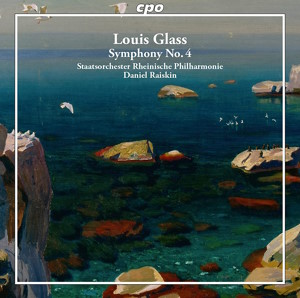
Louis Glass (1864-1936)
Symphony No. 4 in E Minor, Op. 43 (1903-08)
Staatsorchester Rheinische Philharmonie/Daniel Raiskin
rec. 2014, Koblenz, Germany
cpo 777 898-2 [55]
Danish composer Louis Glass’s Fifth Symphony is his finest symphony. It is a glorious work and makes him, to all intents and purposes, a one-hit composer. Back in the 1980s I discovered it through the kindness of a Danish friend who introduced me to swathes of rare Danish music from 1800 to 1950. Entirely my fault, but I lost touch with him when I moved to Scotland and new employment. In any event the Fifth is breath-taking, exciting and enduringly loveable especially in the Danish Radio broadcast version by Michael Schønwandt and the Danish Radio Symphony Orchestra. I have since inflicted that version – well just the first movement, actually – on several recorded music societies in the North-West of England. My cassette of Schønwandt has begun to wear raw and thin such that sadly a home-made CDR transfer sounds less than immaculate but such a performance.
All six of the Glass symphonies have been recorded before. These were by Danacord in low voltage versions from Plovdiv. In addition there have been a small handful of ‘one-off’ and historical broadcast CDs (Marco Polo and Danacord). The Fourth was superbly done, on Danish Radio only, by the Finn Jorma Panula with the Danish RSO during the 1980s. The un-urgent Plovdiv version does not represent Glass and this work at his best. From the same Danish source I ‘learnt’ the Third Symphony in a reading by Alf Sjøen conducting the Aalborg orchestra. David Raiskin and cpo have already issued the Third (previously championed by Sjøen and Edward Downes in Manchester)Fifth. Here is the four-movement Fourth Symphony.
Daniel Raiskin sympathetically directs the Staatsorchester Rheinische Philharmonie. He latches on to the work’s high romance and has us forgiving its moments when Homer nods and the tension briefly slackens. It’s a chunky and, admittedly, gangling Brucknerian work. The four movements include some exceedingly noble passages. It is not Brucknerian in temperament, although the heart that beats has its pages which have a woodland equivalence with Bruckner’s Romantic. There is languor here but spur-stung energy is there as well. You can tell this from the Allegro risoluto of the long first movement, which has its moments of high-flown oratory and delicacy of orchestration. Towards the end it proclaims the stomping staying power of the symphony it immediately preceded.
Unusually, the next movement is an extended Molto vivace – and as elsewhere Raiskin conveys the joy of discovery with a rippling power, both in loud uproar and often in quiet music. Glass could always be relied on for a good long melody of the first distinction. As in the Fifth Symphony of Tchaikovsky, the tune in the third movement, which is another long movement, – an Adagio – bathes us in Russian honey. The sentiment setting registers high. A romping Finale scorches along with some of the high port heaven-assaulting ‘beau sabreur’ energy of Elgar’s Froissart. To relieve the skittish yet sinewy excitement there are patches of conversational balm that serves as a contrasting beau geste. These aspects are redolent of the preceding movement.
Other works that may be helpful parallels and hints as to what to expect, though not always earlier than this Glass piece, are Schumann’s Rhenish, Ludolf Nielsen’s Forest Walk, Bax’s Spring Fire and Bantock’s Pagan Symphony, although the Glass Fourth has a more robust musculature than all of these, apart from the Schumann.
As cpo points out the Fourth Symphony “… calls for triple woodwinds as well as six horns and the strongest wind section that Glass used in his symphonies….[it] immediately attracted attention and was not only performed repeatedly in Copenhagen from 1912 to 1933, but also abroad”. After the composer’s death, it was performed three more times but never really took root, at least not in the way that the Fifth has. If the Fourth is not the equal of its successor there is much in it to relish. Raiskin and cpo have already rolled out the flanking symphonies in great sound and good documentation in German, French and Danish from Claus Røllum-Larsøn. The first two symphonies and the Sixth lie in our and cpo’s future.
Rob Barnett
Previous review: Jonathan Woolf (January 2023)
Help us financially by purchasing from




















